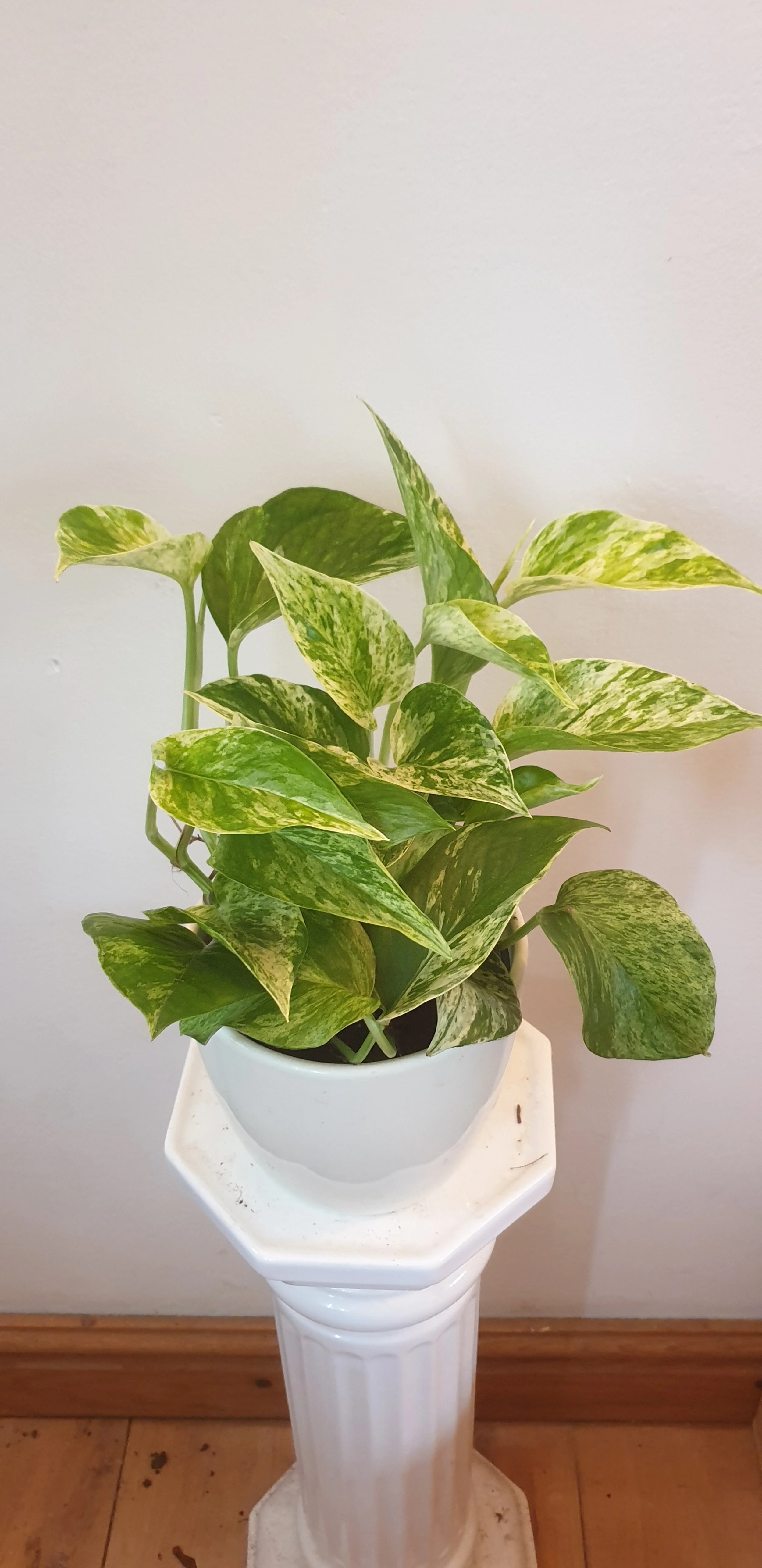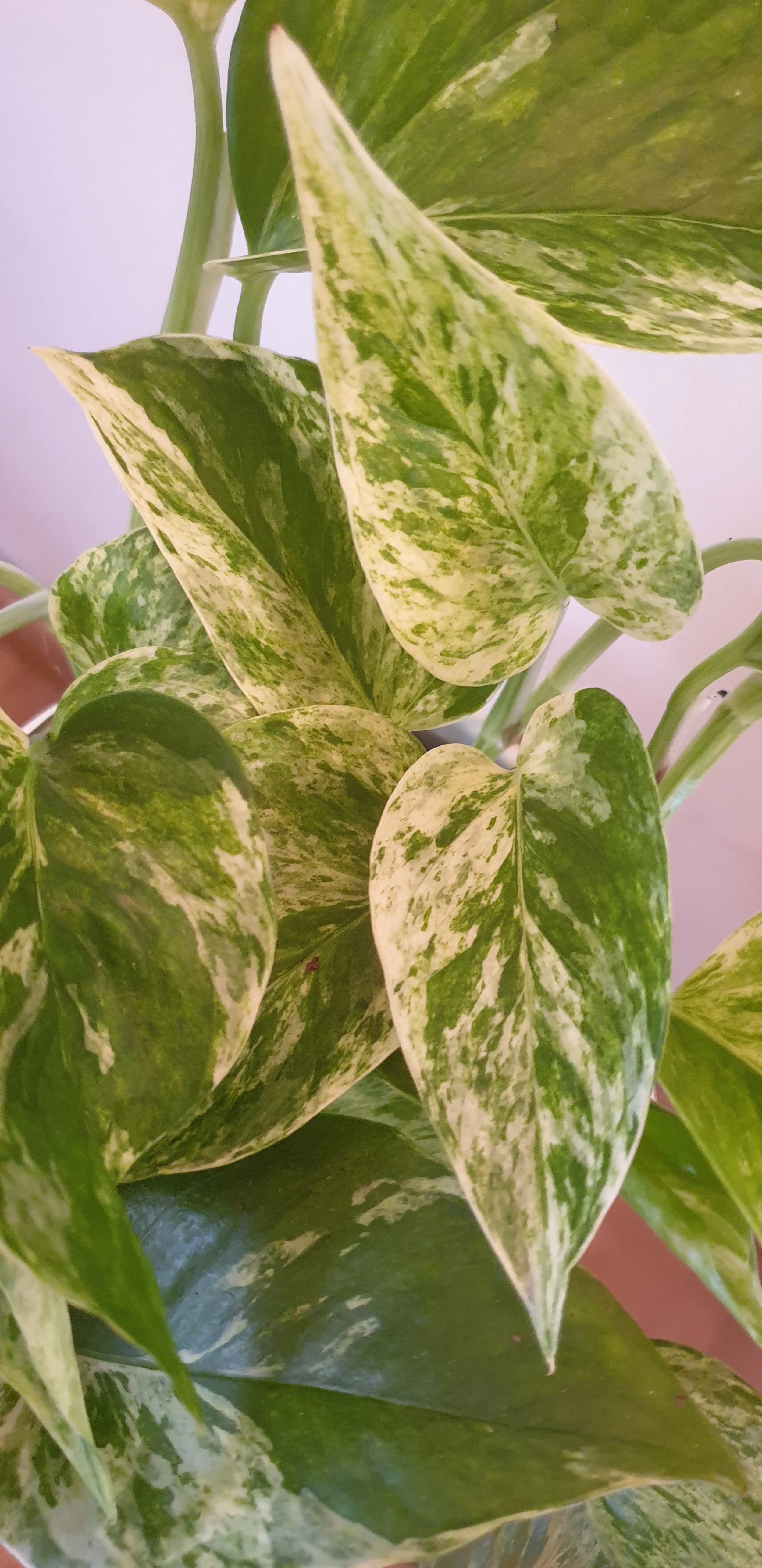 Image 1 of 2
Image 1 of 2

 Image 2 of 2
Image 2 of 2



Epipremnum 'Marble Queen' in 12cm pot.
🌿 Epipremnum 'Marble Queen' – Description
Botanical Name: Epipremnum aureum 'Marble Queen'
Common Names: Marble Queen Pothos, Devil’s Ivy, Variegated Pothos
Family: Araceae
Origin: Cultivar of species native to Southeast Asia and the Solomon Islands
✅ Key Features:
Foliage: Heart-shaped leaves with marbled variegation of creamy white and green, with some leaves almost fully white or cream in high light.
Growth Habit: A vining or trailing plant, grows well in hanging baskets or climbing structures (like moss poles).
Size: Vines can grow up to 6–10 feet (2–3 meters) indoors, though it grows more slowly than other pothos due to the high variegation.
---
🪴 Marble Queen Pothos – Care Guide
This plant is easy to care for and well-suited to beginners, though the variegation means it needs a bit more light than darker green pothos types.
---
☀️ Light
Thrives in bright, indirect light.
Can tolerate medium to low light, but variegation may fade (becoming more green).
Avoid direct sunlight, which can burn the leaves.
---
💧 Watering
Water when the top 1–2 inches (2–5 cm) of soil feel dry.
Do not overwater—it’s susceptible to root rot.
In winter, reduce watering frequency as growth slows.
---
🌡️ Temperature & Humidity
Temperature: 65–85°F (18–29°C)
Humidity: Tolerates normal home humidity but prefers slightly higher (40–60%). Occasional misting or grouping with other plants can help.
---
🌱 Soil
Use a well-draining potting mix.
Ideal mix: standard houseplant soil + perlite or orchid bark to improve aeration.
Ensure the pot has drainage holes.
---
🌸 Fertilizer
Feed every 4–6 weeks in spring and summer with a balanced, diluted liquid fertilizer.
No need to fertilize in fall/winter.
---
🪴 Repotting
Repot every 1–2 years or when rootbound.
Use a slightly larger pot (1–2 inches wider).
---
✂️ Pruning & Propagation
Prune regularly to maintain shape and encourage fuller growth.
Propagates easily in water or soil using stem cuttings with at least one node and leaf.
---
🐛 Common Problems
Problem Cause Solution
Yellow leaves Overwatering or poor drainage Let soil dry more; check for root rot
Loss of variegation Not enough light Move to brighter, indirect light
Brown tips Low humidity or inconsistent watering Maintain even moisture and raise humidity
Pests Mealybugs, spider mites Wipe leaves; use neem oil or insecticidal soap
---
🐾 Pet Safe?
❌ No. Marble Queen Pothos is toxic to pets and humans if ingested (contains calcium oxalates).
---
🧘 Bonus Tip:
Because of its slower growth due to high variegation, this variety benefits even more from bright, indirect light and regular feeding than its greener cousins. If you love trailing plants that stay elegant and colorful, Marble Queen is an excellent choice.
🌿 Epipremnum 'Marble Queen' – Description
Botanical Name: Epipremnum aureum 'Marble Queen'
Common Names: Marble Queen Pothos, Devil’s Ivy, Variegated Pothos
Family: Araceae
Origin: Cultivar of species native to Southeast Asia and the Solomon Islands
✅ Key Features:
Foliage: Heart-shaped leaves with marbled variegation of creamy white and green, with some leaves almost fully white or cream in high light.
Growth Habit: A vining or trailing plant, grows well in hanging baskets or climbing structures (like moss poles).
Size: Vines can grow up to 6–10 feet (2–3 meters) indoors, though it grows more slowly than other pothos due to the high variegation.
---
🪴 Marble Queen Pothos – Care Guide
This plant is easy to care for and well-suited to beginners, though the variegation means it needs a bit more light than darker green pothos types.
---
☀️ Light
Thrives in bright, indirect light.
Can tolerate medium to low light, but variegation may fade (becoming more green).
Avoid direct sunlight, which can burn the leaves.
---
💧 Watering
Water when the top 1–2 inches (2–5 cm) of soil feel dry.
Do not overwater—it’s susceptible to root rot.
In winter, reduce watering frequency as growth slows.
---
🌡️ Temperature & Humidity
Temperature: 65–85°F (18–29°C)
Humidity: Tolerates normal home humidity but prefers slightly higher (40–60%). Occasional misting or grouping with other plants can help.
---
🌱 Soil
Use a well-draining potting mix.
Ideal mix: standard houseplant soil + perlite or orchid bark to improve aeration.
Ensure the pot has drainage holes.
---
🌸 Fertilizer
Feed every 4–6 weeks in spring and summer with a balanced, diluted liquid fertilizer.
No need to fertilize in fall/winter.
---
🪴 Repotting
Repot every 1–2 years or when rootbound.
Use a slightly larger pot (1–2 inches wider).
---
✂️ Pruning & Propagation
Prune regularly to maintain shape and encourage fuller growth.
Propagates easily in water or soil using stem cuttings with at least one node and leaf.
---
🐛 Common Problems
Problem Cause Solution
Yellow leaves Overwatering or poor drainage Let soil dry more; check for root rot
Loss of variegation Not enough light Move to brighter, indirect light
Brown tips Low humidity or inconsistent watering Maintain even moisture and raise humidity
Pests Mealybugs, spider mites Wipe leaves; use neem oil or insecticidal soap
---
🐾 Pet Safe?
❌ No. Marble Queen Pothos is toxic to pets and humans if ingested (contains calcium oxalates).
---
🧘 Bonus Tip:
Because of its slower growth due to high variegation, this variety benefits even more from bright, indirect light and regular feeding than its greener cousins. If you love trailing plants that stay elegant and colorful, Marble Queen is an excellent choice.